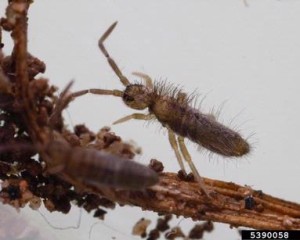Summer Weather Can Bring Pests That Feed on Mold
By Chris Williams on August 5, 2015.

Springtail
The hotter and more humid weather of summer brings calls about mold insects. Infestations of these moisture pests are often ongoing, but cyclical. Mold pests will drop in number or seem to disappear during cooler, drier months, only to mushroom again during warmer, damp weather.
There are three main groups of insects that feed on fungus and show up in buildings when conditions allow mold to grow on surfaces. Mold doesn’t always mean a blue or green fuzz growing on a surface; mold can also be invisible to the naked eye. In these cases, it is often first assumed that the pests are feeding on the surface itself (grain, wood, books), when it’s really the mold that they’re after. Mold pests are primarily nuisance pests and don’t do any damage in structures other than possible food contamination.
Springtails – Also called Collembola, these insects are very tiny (1/16 inch) come in a range of colors, and can be found in large numbers. They can jump with a spring-like appendage on their abdomens. They’re most common indoors on damp, moldy paper, wood, or fiberboard. See Springtails in Damp Areas.
Fungus Beetles – This group includes several different beetles that are all dark and tiny (1/8 inch). The plaster beetle, mold beetle, and the foreign grain beetles are all common pests in new construction where they are found on moldy and still “green” wood, plaster, drywall, or other damp building materials. Some will also infest moldy grain products. See Fungus Beetles Mean Things Are Too Damp.
Booklice – Also called psocids, these insects are not related to lice, but instead are usually found in damp moldy books and papers, and sometimes in moldy food products. They are whitish, wingless, and soft-bodied and look somewhat look termite workers except booklice are smaller (1/8 inch). See Booklice Are Not Baby Termites!
Besides these three groups of insects, other pests that can be associated with mold or fungus are fungus gnats, fungus moths, and mold mites.
Getting Rid of the Mold Gets Rid of the Mold Insects
Mold-feeding pests can be easy to control if the site can be dried out. Once the mold is gone, the pests will either die or move on. Drying the site might mean roof or plumbing repairs, correcting drainage or condensation problems, or installing a dehumidifier. In the best-case scenario, the mold pests are infesting wet, moldy items, like old newspapers, that can simply be discarded.
Drying out a chronically damp area in a home or other building can take some time. In the meantime, you may need insecticide treatment to kill mold insects as they continue to appear. Give Colonial Pest a call. We do pests so you don’t have to!
Photo Credit: Joseph Berger, Bugwood.org